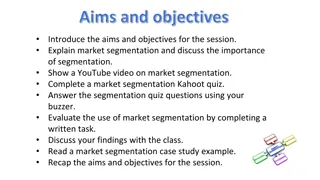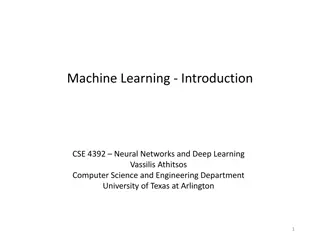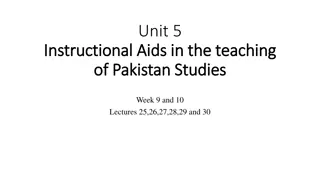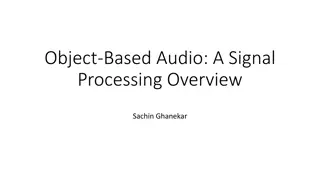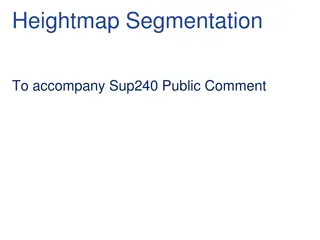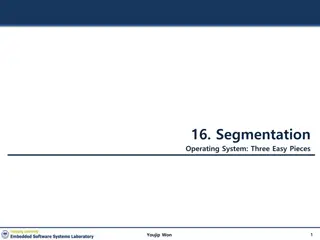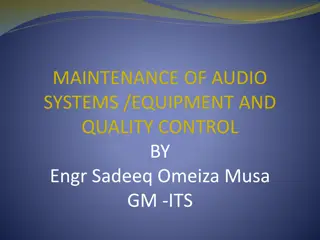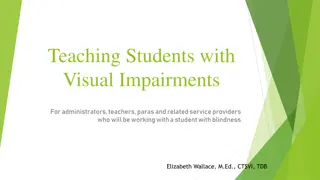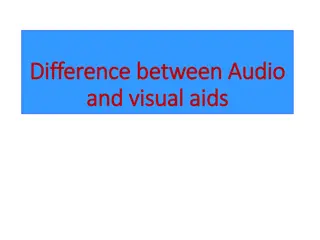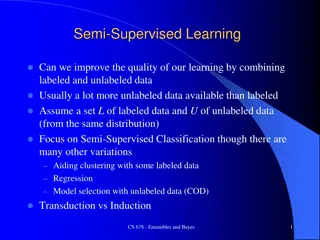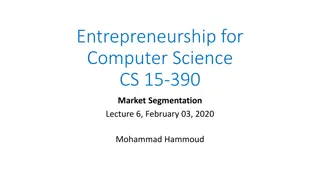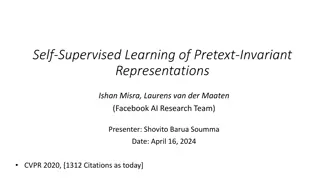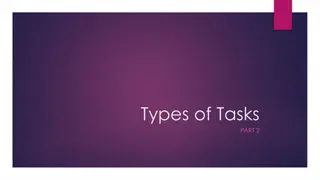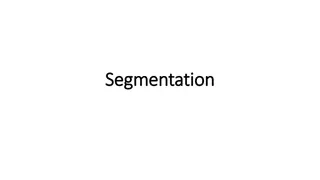Exploring Self-Supervised Audio-Visual Learning for Segmentation Tasks
Researchers from the Weizmann Institute of Science delve into the realm of self-supervised audio-visual learning for segmentation tasks, leveraging the correlation between visual and audio events to jointly train networks for enhanced understanding. Motivated by the potential of unsupervised learning, they aim to extract valuable insights from unlabelled videos through a constructed Audio-Visual Correspondence (AVC) learning task. The study outlines key approaches and findings related to this innovative learning paradigm.
Download Presentation

Please find below an Image/Link to download the presentation.
The content on the website is provided AS IS for your information and personal use only. It may not be sold, licensed, or shared on other websites without obtaining consent from the author. Download presentation by click this link. If you encounter any issues during the download, it is possible that the publisher has removed the file from their server.
E N D
Presentation Transcript
SELF SELF- -SUPERVISED AUDIO SUPERVISED AUDIO- - VISUAL CO VISUAL CO- -SEGMENTATION SEGMENTATION Weizmann Institute of Science Department of CS and Applied Math. By: Ilan Aizelman, Natan Bibelnik
Outline Outline Part 1 Look, Listen and Learn by Relja Arandjelovic and Andrew Zisserman Objects that Sound by Relja Arandjelovic and Andrew Zisserman Part 2 Learning to Lip Read from watching videos by Joon Son Chung and Andrew Zisserman Dip Reading sentences in the wild by Joon Son Chung
Before we begin Before we begin There are many papers that.. Were published almost in the same time, and are very similar
Audio-Visual Scene Analysis with Self-Supervised Multisensory Features (OCT 2018)
Look, Listen and Learn Look, Listen and Learn by Relja Arandjelovic and Andrew Zisserman
Motivation: Motivation: they use self-supervised learning Unsupervised learning The datasets do not need to be manually labelled. Training data is automatically labelled. Goal: finding correlation between inputs
Main focus: Visual and Audio events Main focus: Visual and Audio events Visual and audio events tend to occur together: Baby crying..
What do we learn? What do we learn? What can be learnt by unlabelled videos? By constructing an Audio-Visual Correspondence (AVC) learning task that enables visual and audio networks to be jointly trained from scratch, we ll see that
Given 1. Given Audio input, what s the related Visual output? Also Called: Cross/Intra-mode retrival l Neural Network will learn useful semantic concepts Predict
2 2. Localization! . Localization! Which sound fits well with this image?
Our main focus in this paper 3. Correlation 3. Correlation Does the (Visual, Audio) pair correlated? Yes: Positive No: Negative
High High- -level Overview level Overview The Network should learn to determine whether a pair of (video frame, short audio clip) correspond to each other or not.
The NN learns to detect various semantic concepts in both the visual and the audio domain
Network Architecture Network Architecture Inputs: Frame One second audio clip Output: Predict if frame corresponds to audio clip
Fusion network Fusion network then passed through 2 fully connected layers. Outputs are concatenated,
Implementation details Implementation details Training Kinetics dataset (human action classification) approx 20k videos with labels. Labels are used only for baselines. Flickr Dataset (sentence-based image description) The first 10 seconds of each of 500k videos from Flickr.
Sampling Sampling Video 1 Corresponding pair: pick a random 1 second sound clip from a random video, then select a random frame overlapping that 1second. Video 1 Non-Corresponding pair(Negtive): pick two random videos, and take a random frame from one and a random audio clip from the other. Train on 16 G P U s for two days . Video 2
Evaluation results of: AVC Task AVC Task We evaluate the results on 3 baselines:
Supervised direct Supervised direct baseline (supervised learning) 1. Same networks (Visual and Audio) supervised train 2. Modified FC layers - output to 34 action classes. 3. Finally, correspondence score iscomputed as the similarity of class score distributions of the two networks.
Pre Pre- -training training baseline 1. Extract Visual and Audio trained features 2. Concatenate both features into original ?3 Network 3. Freeze weights and train only FC layers on AVC task
Visual features evaluation independently Visual features evaluation independently Trained on Flickr-SoundNet, evaluated on ImageNet. The methods below use self-supervised learning. Also, other self-supervised methods trained on imagenet. Random Alexnet + trained classifier Colorization Jigsaw Audio-Visual Correspondence
Audio features evaluation independently evaluation independently the ?3-Net audio subnetwork trained also on Flickr-SoundNet is used to extract features from 1 second audio clips. Effectiveness of these features is evaluated on two standard sound classification benchmarks: ESC-50 (Environmental audio recordings) and DCASE (Acoustic scene classification)
Audio features evaluation independently Audio features evaluation independently Apply audio subnetwork to ESC-50 and DCASE, two sound classification datasets. Break into 1-second clips, features are obtained by max pooling the last conv layer, pre-processed with z-score normalization, and at test time evaluated with a multi-class SVM on the output. Compare with other self-supervised classification methods, and with Soundnet
Paper Paper 2 2: Objects that Sound : Objects that Sound by Relja Arandjelovic and Andrew Zisserman Objectives: 1. networks that can embed audio and visual inputs into a common space that is suitable for cross-modal and intra-modal retrieval. (new) a network that can localize the object that sounds in an image, given the audio signal. (new) 2.
But.. How?? Same way as before We achieve both of these objectives by training from unlabelled video using only audio-visual correspondence (AVC) as the objective function. But different Architecture
Localization Localization
AVE AVE- -NET NET
AVE-NET Architecture This part is the same as previous architecture
To Enforce Alignment Directly Optimizes the features for cross-modal retrieval
Evaluation and results Evaluation and results Trained on: AudioSet-Instruments train-val set Task: AVC AVE-NET: 81.9% ?3-Net: 80.8% AVE-NET won in the AVC task BUT . The REAL test of interest here is the retrieval performance.
Evaluation of Cross Evaluation of Cross- -modal and intra The performance of a retrieval system is assessed using a standard measure the normalized discounted cumulative gain (nDCG). It measures the quality of the ranked list of the top k retrieved items. modal and intra- -modal retrieval modal retrieval Cross-modal and intra-modal retrieval. Test set: AudioSet-Instruments
Why intra-model works? Transitivity: An image of a violin is close in feature space to the sound of a violin, which is in turn close to other images of violins. The AVE-Net outperforms the ?3-Net because its Euclidean distance is aware , i.e. it has been designed and trained with retrieval in mind.
Localizing objects that sound Localizing objects that sound Goal in sound localization is to find regions of the image which explain the sound. We formulate the problem in the Multiple Instance Learning (MIL) framework. Namely, local region-level image descriptors are extracted on a spatial grid and a similarity score is computed between the audio embedding and each of the vision descriptors.
Audio Audio- -Visual Object Localization (AVOL Visual Object Localization (AVOL- -Net) Net) 14x14 128-D vector 14x14x128 Grid
produces the localization output in the form of the avc score for each spatial location FC to Conv calibration FC1 & FC2 converted to conv5 conv6
Hypothesis: the network detects only salient objects Hypothesis: the network detects only salient objects What in the piano-flute image would make a flute sound?
Conclusions Conclusions We have seen that the unsupervised audio-visual correspondence task enables, with appropriate network design, two entirely new functionalities to be learnt: 1. cross-modal retrieval. 2. and semantic based localization of objects that sound. The AVE-Net was shown to perform cross-modal retrieval even better than supervised baselines The AVOL-Net exhibits impressive object localization capabilities.


